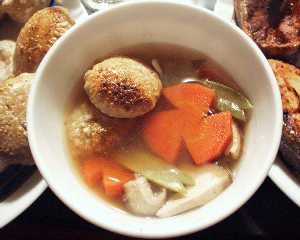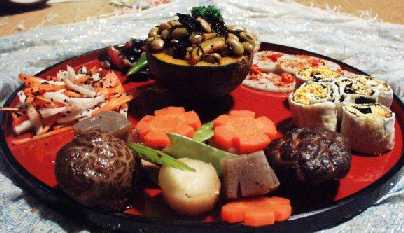
|
→レシピ集目次へ | |
|
Ms.シャローム流伝統逸脱日本食材料理法 |
|
2001年
日本伝統の食べ方にこだわらない、Ms.シャローム流「日本の食材利用方法」です。
頭の柔らかくなる何でもあり料理法です。
-黒豆赤飯(小豆の代りに黒豆使用の赤飯。黒飯?)
-味噌を、日本料理以外でも、塩やだしの素の代りに使う。
-ソバ粉パン
-ヒラタケのパプリカ入りオリーブ漬け
-フキノトウオムレツ
-ターメリック+昆布味ごはん
-ヨーグルト+粉末豆乳+ワカメをのせたジャガイモの網焼
-小麦粉+きな粉クッキー
-チョコレート餅
-バニラ餅
-トマトソース味豆腐
-青豆カツ(肉の代りに青豆使用)
-凍豆腐カリカリ天(水を切ってさいの目切りした凍豆腐をカリカリに揚げた天ぷら)
-納豆入りペーストリー(くぼみに納豆をのせ、おろしチーズ、青ノリ、ハーブをふりかけた焼菓子。ペーストリーの代りにトーストでやってもよい。)
-大葉トースト
-おろしチーズ豆腐
How I like Japanese food stuffs.
(おせち料理↓/2002年元旦)





「我が家の正月とおせち料理」
I cook some osechi-ryouri, but not anything serious to properly qualify.
A close friend of ours in Ibaraki used to make Misoka-soba and Ozoni. She invited my parents and us one year, and it sort of stuck with us, so I do make that much most years, especially Ozoni.
Our next door neighbour winters with her children in Kawasaki, so she left us her mochi making machine. Last night we tried making kakimochi for the first time. I think I might make more tonight.
My children like kiri-mochi microwaved with vanilla, a strange concept that goes to show some of us are born international... I hope more of us do with time.
Every year we go to jinja just before midnight on new year's eve to enjoy the taiko, bells and ceremonies. Somehow it feels like a nice way to begin the new year, although it is in not really a religious experience for any of us. On the day we often go to a temple, perhaps buy a Dharma to add to the charms we bought the night before :-)
Last year I was upset that we had been buying large Dharmas every year but did not have a house yet (it was just after we were refused a small loan on the grounds of being gaijin), so we did not buy any Dharma but we did buy a house :-) What a funny coincidence. We will probably get a new Dharma again this year...
I also make shimenawa-kazari and soemtimes a special ikebana for the day.
I carved flower shapes out of mochi for the arrangement. Not very traditional, but we liked it anyway.
「私の日本の食材利用方法」
I probably cook most things somewhat international, and often partly Japanese, for the simple reason that the ingredients are easy to get. As a variation on sekihan, I like using kuro-mame instead of azuki sometimes, or other beans. I put miso in non-Japanese dishes, instead of salt/ chicken stock. My soba-bread has got popular among my Japanese friends who originally found the idea very peculiar. Many of my soups are based on miso, but are too full of "gu" to be called miso-shiru. I like hira-take in olive oil and hot paprika, fuki-no-to in omelet, herbs in just about everything. I do not really think of it as Japanese foods cooked differently but Japanese ingredients used freely without cultural preconceptions. Thus I can have rice in turmeric and konbu; potatoes grilled with yoghurt, soy milk powder and wakame; kinako in cookies (instead of a portion of the flour) and so on.
I have no problem eating mochi with chocolate, tofu with tomato sauce or aodaizu as a meat substitute in cutlets. One of his favourites is defrosted tofu (drained and cut in cubes) deep fried until it is crisp. I think you probably get the drift :-)
Actually, that reminds me of a couple of things I eat which you may consider sufficiently unusual. One is natto in baked pastry pockets, usually with grated cheese and aonori or herbs, and the other is toast with the same or toast with ooba and tofu and grated cheese on top.
Have you ever tried rice porridge as a sweetened breakfast or for dessert? I can have it with spice, such as cardamom and cinnamon, with chocolate or vanilla, or even with coconut milk
:-)
「私が宇宙旅行するなら」
If I went away somewhere I would have a real problem what to take with me. I know that for a fact because it actually happened. On my first stay in Japan, for over four years, I missed lentils and certain kinds of beans, as well as milk products and chocolate. I then moved to Spain where all that was easily and cheaply available. However, that is when I started looking real hard for shoyu, shiitake, miso and sea-weed, and once I found a shop, I was willing to pay a fortune for it even when I could not afford much else.
I remember paying for tofu more than for going out to a restaurant to eat, and it was not even particularly good or fresh, but it meant the world to me. As soon as we landed back in Japan we had oden... I guess I have been cursed with being too international in some ways, and I need to have everything now. (Luckily, obtaining unusual stuff is no longer so difficult these days, thanks to internet shopping).
So if I ever went to space I would probably just take a little greenhouse with me, much like the planned mission to Mars :-)
But there is one thing I would not be able to take with me- sunshine! I love the sun more than anything else but my family, so I am unlikely to leave for space...
「日本人の食習慣と作法」
For me the ultimate awful Japanese food habit is salt on fruit; I will never get used to that... I love fruit, and I love it fresh and salt-free. I also love fresh vegetables, which a Japanese diet is typically short of, so I just take what I like of each world and mix it to produce my own, and it can definitely get strange...
When I was first served salted suika and apple in Japan, I thought the hostess must had had sweaty hands; for the life of me I could not imagine the salt had been put there on purpose! :-) Nevertheless, I always liked suika with salted chips (fried potato) or white hard salt cheese ...
While we're at it, I was also shocked when I first went into a ramen shop, by the extreme slurping, which is just about the rudest thing to do at a meal table in the West. Ruder than that would be, please excuse me, burping or farting, the former expected at Arab tables at the end of a meal (or else the hostess assumes you did not like the food or did not have enough), and the later showed comfort by the Roman meal tables...
I don't remember the exact name of the movie, something like the Smallest Tea Shop in Japan, that started with "pornography is a matter of geography", how true!